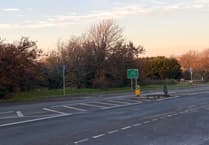"A day will be well spent here; a row across the bay, of two and a half miles, being one of the especial treats of visitors, to examine the walls and remains of a castellated mansion which now form parts of a modern dwelling - residence of the gentleman who owns the old nest of the sea-kings. There are other objects here to arrest attention; an ancient tower; and an inscribed stone, still more ancient."
S.C. Hall 1860.
Only a 20 minutes' boat trip away from the mainland and clearly visible from Tenby's Esplanade and South Sands is the delightful, fertile island of Caldey.
Those alighting on the island's safe and sandy landing bay are helped onto the jetty by capable boatmen, many of whom also crew Tenby's lifeboat. The boatmen are very helpful to the less able, and landing is simple, thanks to Caldey's extended jetty, constructed from old wartime concrete barges. At very low tides, amphibious landing craft carry passengers the final 30 yards, much to the delight of children aboard.
Now look back across the water to Tenby and you will see the ancient town sparkling in grand perfection, with fine Georgian and Victorian houses gracing majestic cliffs.
As the townspeople see it, Caldey appears to be long and very narrow, with a lighthouse on its mid-point. In fact, the lighthouse is on high cliffs at the far end of the island, which measures one mile wide and just over two miles long. It is one of the many vantage points from which to observe puffins, cormorants and seals, and to enjoy the splendid views of Pembrokeshire coastline.
Years ago, at Whitsuntide, Caldey used to play host to large shooting parties, arriving in small boats to enjoy their sport with a picnic and plenty of drink. Puffins and rabbits were popular game; sea-birds were in high demand while the fashion for gull-wing hats lasted.
Islanders would trade farm produce and sea-birds' eggs with passing ships, who were anchored to shelter from bad weather. Once the railway was built, it was not long before trade ships became scarce.
For over 70 years the island has been the property of Cistercian monks. Their red-roofed limestone monastery was modelled on a Swiss design. It occupies the middle of the island, concealing within it austere cells, cloisters adorned with religious icons, and a refectory for silent meals. Austerity is continued in the Abbey Church, which boasts neither stained glass window nor hassock, but is filled with the sound of birdsong and the scent of flowers.
Life for the monks is a daily balance of prayer, study and worship with manual labour. Surely all these have worked together to provide a unique island industry which keeps visitors well supplied with home-made yoghurt, clotted cream, biscuits and cakes at the island tea-gardens, a short walk from the landing bay. The monks' home-made chocolate is in high demand and can be bought in a number of mainland shops as well as on the island. The monks also have their own range of exquisite perfumes, scented with various Caldey island flowers.
'Pilgrims' to the island might like to visit the Priory Church of St. David, with Dom Bede Bailey's brightly coloured stained-glass 'Fish Window'. The design was based on the 'Icthus', a symbol used by early Christians who noted that in Greek the five initial letters of the phrase 'Jesus Christ, Son (of) God, Saviour' spelt the Greek word for 'fish'.
The symbol is still widely used today to denote Christianity and also appears on Caldey's postal stamps - yes, you can even send a postcard from Caldey, by buying an extra '2 dab' stamp and using the island Post Office.
The pilgrimage continues to St. Illtyd's Mediaeval Priory Church, lovingly restored from the effects of dissolution by Rev. Done Bushell in 1897. Rev. Bushell had bought the island in 1897 and was largely responsible for bringing back monastacism to Caldey, over 400 years after the Reformation had all but destroyed it. St. Illtyd's Church is distinguished by its leaning spire, which is said to be three feet out of perpendicular. Inside, the cobblestone floor and rush mats glow in candlelight.
Housed in the church is the five-foot Ogham Stone, which had been dug up from beside a neighbouring well in the 18th century. The treasure was initially utilised as a window sill, then as a garden seat, before its real value was known. It bears two inscriptions, one in the ancient writing form known as Ogham, the other in Latin. The stone is thought to date from the sixth century and may have been commissioned by St. Illtyd, when Patron Saint of Caldey, St. Samson, was the island Abbot.
Enjoy walking around the island, which has some lovely areas of unspoilt beauty. Remember to respect the Abbot's wishes, and in the interests of safety, keep to public paths.
Caldey boats depart regularly from the end of Tenby's stone quay or Castle Beach, depending on the tide. Tickets and times can be obtained from the ticket office on the harbour. Private landings are permitted only by prior arrangement with the Abbot.



